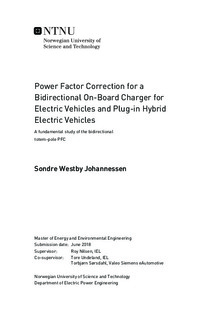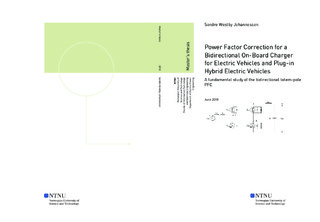| dc.description.abstract | With the beginning implementation of a smart grid in industrialized countries increasing
the load flexibility of customers, as well as communication with the grid
operators, a potential market for bidirectional on-board chargers (OBC) is emerging.
The OBC is the electric vehicle charger located within the vehicle, operating
as a link between the DC-voltage battery and the AC grid voltage in electricity
sockets anywhere, thus working at a universal voltage range (85Vrms-265Vrms)
with rated power in the range of 1.9kW to 3.5kW. To maximize the real power
drawn by these OBCs, they are designed with power factor correction (PFC) converters
at the AC grid interface, shaping the drawn AC current sinusoidally and
in phase with the AC voltage, to maximize the power factor. Thus, a bidirectional
OBC would necessarily require a bidirectional PFC. In this master s thesis,
a simulation model is developed for a bidirectional totem-pole PFC, attempting
to verify the use of this topology as the mentioned bidirectional OBC PFC. The
work is focused on describing the basic bidirectional operation of the bidirectional
totem-pole PFC, deriving expressions for currents, voltages and losses, as well as
for the gate logic and control system. Average current mode control is used, with
cascaded current and voltage control including PI controllers and Symmetrical optimum
tuning. To verify the simulation model for the power levels and demands
of an OBC, the main components are dimensioned to achieve 98% efficiency at
230Vrms, 3.5kW and 90kHz switching frequency, implementing GaN eHEMTs in
the fast-switching leg of the totem-pole. At last, simulations are performed, showing
that the PFC is able to achieve a power factor of 0.998 and a THD of 5% in
both G2V and V2G, without a DM filter on the AC side. | |

